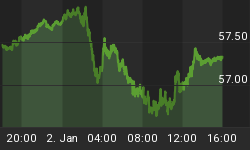While officials from the Federal Reserve gather recently in Jackson Hole Wyoming to bemoan that inflation isn't yet high enough for their liking, the truth is that inflation is already ravaging the middle class.
To prove my point, the government's official reading on core CPI inflation (one of the Fed's preferred metrics that removes food and energy prices) increased just 1.7% from July 2012. So, in the mind of those who control the value of our currency, inflation is well below their target of 2%; and therefore needs to be increased.
Nevertheless, let's try another, more real-world way of calculating the data. The labor department correctly judges that prices paid for shelter should be a significant proportion of the core CPI calculation (about a 40% weighting). According to the Labor Department, prices for shelter increased only 2.3% from July of last year. When the government uses such an incorrect assessment of home price appreciation it is then able to report only a slight increase in core inflation.
However, according to the National Association of Realtors, existing home prices surged 13.7% YOY. And new home prices jumped 8.5% YOY, according to the Commerce Department. If you include the increase in the other items in core CPI ex-housing (up 1.2% YOY) a more accurate measurement of core CPI can be achieved. Consumer prices would be up 5.1% from the year ago period--assuming you simply average the cost of purchasing a new with that of an existing home. In reality existing home purchases exceed the number of new home sales and would therefore increase the core rate reading. Of course, the difference between the government's data and what is collected from private sources is that the Bureau of Labor Statistics measures the imputed rental value of homes, instead of actual increases in what consumers have to pay for real estate.
A core rate of inflation that is rising north of 5% YOY should send shivers down the spines of those at the Fed and consumers alike. Amazingly though, Mr. Bernanke is still debating if a $3.6 trillion Fed balance sheet and the $85 billion worth of new credit creation each month is doing enough damage to the value of the dollar. The Fed's inflation is especially painful to the middle class due to the fact that real median incomes have fallen 6.1% since the start of the Great Recession, which began in December 2007.
Our economy is so addicted to money printing that the Fed can't agree on when, or even if, it should reduce the level of its asset purchases. Mr. Bernanke's confusion over monetary policy is evident despite the fact that he has built up a stock, bond and real estate bubble. This trifecta of asset bubbles exists concurrently for the first time in American history.
Our central bank will soon have to decide whether or not it will continue allowing these bubbles to grow to a more dangerous level (intractable inflation); or to start selling trillions of dollars worth of bonds and send interest rates soaring. We already have witnessed what a mere one percent increase in mortgage rates did to new home sales (down 13.4% in July, the lowest level in 9 months). This occurred without the Fed tapering its purchases of MBS and Treasuries by even one dollar. Just imagine what will happen to interest rates when the Fed not only stops buying that debt; but also starts unloading its balance sheet.
It seems apparent that we should prepare for fireworks in the bond, currency and equity markets across the globe in the very near future no matter what Mr. Bernanke decides to do. Therefore, it would be prudent to purchase portfolio insurance in the form of precious metals to help mitigate the fallout that is sure to come from massive central bank manipulations.
Michael Pento is the President and Founder of Pento Portfolio Strategies and Author of the book The Coming Bond Market Collapse.
















